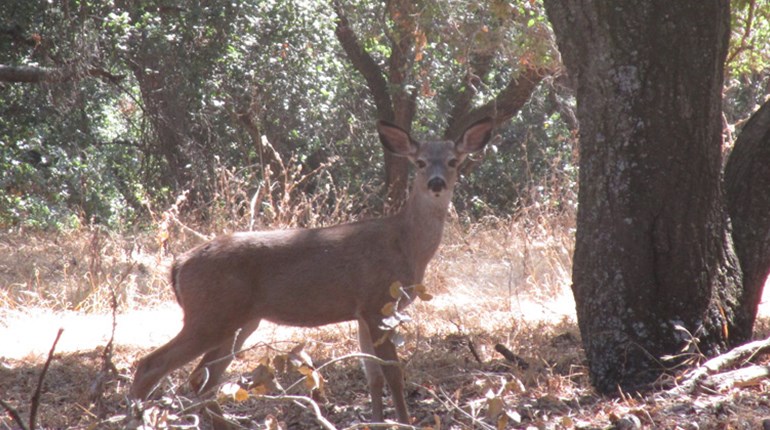August 8, 1804: “I saw a great number of feathers floating down the river … . We did not perceive from whence they came.” So wrote Meriwether Lewis, who later spied a sandbar crowded with pelicans.
The Corps of Discovery learned to look for the unexpected—and to prepare for empty land. Mule deer, evidently common in much of the Louisiana Purchase, diminished after pioneers shot them for meat. The Homestead Act of 1862 hammered deer. Settlers cut timber from creases in the prairie then plowed it bare. In 1879 John Wesley Powell suggested a viable plot on the plains comprise 2,560 acres. Congress allocated 160. Overgrazing ensued. As bison vanished, market hunters sold venison to railroad gangs and steamboat crews. Brutal winters in 1886 and 1887 rested the range by killing 80 percent of its cattle. Deer died too, however, and more cattle came. Depression and the Dust Bowl ravaged the prairie, but relieved deer of hunting pressure as defeated farmers left. World War II brought another respite, men shouldering rifles elsewhere.
Mule deer are to Western hunting what beach sand is to vacation on the coast. Hunters with gray muzzles remember deer were plentiful. From the late 1940s through the ’50s, mule deer hunting was as good as it had ever been—and better than it may ever be again. Decades of heavy grazing had replaced grass with brush. Seasonal use by domestic sheep kept browse in early-successional stages, nourishing deer. Poison and aerial gunning put coyotes on the ropes. A series of easy winters boosted deer survival.
Such a shower of benevolence is unlikely to repeat anytime soon. Western ranges now hold fewer sheep, more coyotes. Fire control on public range and forest limits setback of plant succession. Elk have grown their range, digging deeper and traveling farther than deer to survive in winter’s snow. Wolves kill deer as well as elk. More sportsmen compete for hunting opportunity. They’re more mobile, and equipped to kill at longer ranges. Perhaps most importantly, the U.S. population has topped 300 million. Each year we add more than 7,000 to our number. We build houses where deer live and pave 11,000 miles of roads annually. From the North Dakota oil patch to ski slopes in Colorado and the lights of Hollywood, Western deer habitat is shrinking in the face of human pressure that has nothing to do with bullets.
Still, restricted hunting has produced bigger bucks. Not long ago I spoke with a young man who had shot a non-typical mule deer scoring over 300 points—biggest in two decades! And at the Boone & Crockett meetings just last summer I ogled a typical Nebraska rack that taped over 200. But muley bucks older than 5 are scarce most places. A surplus of such deer must be afoot to give you a chance at exceptional antlers. Or even a buck post-war hunters would have shot on season’s last day.
Where the Deer Are—Now
“There!” In a rippling tide of grass, a buck and a doe dashed away from us. A cleft in the hills swallowed them quickly. Travis and I followed, sweeping crosswind, then into the shadow of a draw. Travis pulled up and pointed. On a treeless slope about 350 yards off, the buck stood, watching behind him. Crouching, we backed off. “I must get closer.”
Travis shrugged. The unspoken message: A long shot is better than none.
To me, a shot too long isn’t a shot at all.
The tall grass covered us to the hem of a gentle ridge. I crawled up, then bellied along its crest to a small, wind-whipped sage. The buck came clear in my 4X Zeiss as the Ruger carbine nosed through the bush. Staggered by the hit, the deer managed a couple of steps before tumbling to lay still. I dropped the No. 1’s lever and pocketed the hull. “Just like my first deer,” I grinned back at Travis.
Well, not exactly. Both rifles were chambered in .303 British. But decades earlier I’d hunted deer in woods, not over the leks of prairie chickens. Another difference: This buck had bigger antlers.
South Dakota, Kansas and Nebraska boast many whitetails and enough mule deer to lure hunters once bound for the Rockies. Though BLM and USFS tracts don’t blanket the prairie, public hunting areas abound. Ditto private ranches with fee access. In Nebraska’s Sand Hills not long ago, I visited Scott Fink and Jim Kuhn, who run low-key hunts in delightful country. I shot a beautiful buck.
Reservation land in South Dakota, where Travis and I nailed the whitetail, produces regularly for a group of my colleagues. Last year every hunter got a mature buck. Lottery odds for drawing a whitetail or a mule deer tag remain good. Not so, always, the weather. A blizzard marked my first Dakota deer trip. Snow on I-90 piled to the over-passes; Deadwood recorded 45 inches. With my tribal guide (required) I persevered, probing brushy draws pinched almost shut by drifts. A muley buck jumped from one and ran into a bullet from my .30-30. He stumbled, recovered, stopped just shy of timber. A second shot ended it.
Naturally, deer bumped from cover run toward other cover. Last fall, on a dawn chilled by arctic wind, I glassed a broad, barren drainage. There seemed no place for deer to hide. Hunkering in tall grass, I fought the urge to find trees. Suddenly, movement! Two deer bounded into view. I “did not perceive from whence they came.” As diving ducks riding rough chop, they vanished as quickly. I dashed forward and flung myself prone on a hummock. The earth disgorged the animals again. When both slowed, I glued the crosswire of my .270 to the buck’s rib. He paused. I fired.
Those deer had ghosted across that treeless depression in the half-light before turning up within a few yards of me. They succeeded not only at hiding but moving in open country undetected. Sure, deer take advantages of cattails and cottonwoods. But grass works too—especially where there’s topographic relief. As hunters prowl timber’s edge and hop-scotch from one plum thicket to the next, savvy bucks find less obvious hideouts.
Not Just Sharp but Smart
Deer are tough to see largely because they appear as shards of the insignificant. That’s why even in the open, they escape notice. Shadow imposes confusing patterns, grass adds striations. To cut through this veil, look between and beyond what you know is not a deer. In grass as in woods, deer come to your eye as patches of earth-tone color on background that’s not much different. A deer’s body texture—gentle folds and ripples, with fine shading—has that background look as well. Your eye, slave to your thinking, craves details peculiar to deer. Antlers, for instance. Chalk bone pops from dark cover. But such obvious clues are often obscured; to see more deer you must discern less distinctive parts.
Look close first, then far. A deer you miss nearby is a chance lost. Distant deer aren’t so quickly alarmed. Keep your search low. Engaging other people, we’re used to looking straight ahead. We bring screens and appliances to eye level. In cover, especially grass, deer are easy to overlook, literally. Prairie whitetails and mule deer stand 30 to 40 inches at the shoulder. Bedded deer lie ankle-high, their ears and antlers at the level of your knees. In short cover, bucks find depressions and hug the earth.
Deer can vanish where cover is not only short but sparse. As any hunter knows who’s used a tree behind to hide his outline from game in front, background can erase the image of an exposed buck. A few blades of grass may suffice. Deer choose beds with an eye not only to concealment but to wind coverage, escape routes and thermal protection. All are important, so often the woody cover that looks promising can be less appealing to deer. Bucks soon learn to shun thickets popular with hunters. A pal once shot a big muley on close-cropped pasture, after a season-long effort in nearby forest. This buck had evidently lived there, hidden in ravines. He’d eluded platoons of hunters plying more traditional deer country.
While a binocular is indispensable on the prairie, few hunters tap its potential. They look far but not close. Close is where you want to see deer; if you wanted to see them yonder, you’d be yonder. The value of a binocular lies in its ability to reveal detail. While resolving power helps your eye sift deer from distant vegetation, it can also show you bucks nearby. The glint of eye or antler, a horizontal hyphen of back-line, the curve of an ear—these slivers of deer are easy to miss with the naked eye, even up close. I favor a lightweight, low-power binocular in part because it’s easy to carry, but more importantly because it’s easy to use, with a wide, bright field that doesn’t bob about uncontrollably when I’m winded. A 6x30 or 7x35 also boosts depth of field; you’ll see sharp images farther into thickets.
A deer that wants to examine something stands very still. You’re smart to do the same. You can’t see well when you’re moving. Cover sliding by is a blur of movement that obscures the flick of an ear or tail. Stop often to look, where you can see behind and to the sides as well as forward. Each step opens new windows into cover. Look before they close. Remember that grass is deer cover. Read a section as if reading a page in a book, the binocular still. Panning shows you a lot of cover quickly, no details clearly.
Remember that even motionless, your silhouette draws attention on the plains. Hunt with low sun behind you to absorb your image while illuminating deer ahead.
Not Expectant, Not Surprised
Once, while glassing a fine buck on a Wyoming flat, I watched in despair as he climbed, with a handful of does, a featureless hill. There was no cover for me. The distant horizon swallowed the deer. Suspecting they’d be back, I returned before sunrise the next day. As light seeped onto the sage, the buck appeared a quarter-mile off. He left early, as did the same group of does. They ascended the slope.
Then, to my surprise, the buck vanished. The other deer sifted into the distance, fully visible.
The hills blushing color, I advanced across the flat, dawn to my back. Gaining the slope, I saw it was cut by small fissures. The fissures became coulees. I chose one and eased along its edge. The big deer bounced from its gut. I missed a hurried shot, settled and hit with another. Shaded at midday, that coulee was, in the big picture, a scratch on the plain. It kept the deer comfortable and invisible.
Any place favored by a mature buck is likely to remain attractive to other deer. So the next season I visited the flat again, glassing early from afar, behind an old cottonwood. Sure enough, dawn’s lemon light glinted on antlers. This buck was low enough to stalk; sage would hide me. I scurried forward and up a small rise a short shot from where the buck would be.
He was not there. The grass lay empty. Then, a snort. The buck bounced off to my left. Whether by design or happenstance, he’d taken a turn behind the rise. Though exposed, he escaped notice because I expected him elsewhere. A rookie’s mistake.
The buck slowed to a trot to make his way up a hill nearly a mile away. I’d written him off when, to my surprise, he stopped on the horizon and dropped into the sage. Bedded! I backed off then crawled into a wash. There, hidden by the curve of the hill, I made better time. Prickly pear burned my knees as I crawled, then dropped to my belly. Many minutes later I spied antler tips just 20 steps ahead. Inching to a gap in the sage, I struck the earth with my foot. The deer stayed still. I had to repeat several times, so sure was this animal of its security. At last it rose. A shot from my iron-sighted Savage ended the drama.
Glassing deer in likely places, then the unlikely places you think are likely because they’re unlikely, can give you fits. Last fall my pal Scott and I hunted in a complex of canyons that had produced fine bucks before. They were ideal for mule deer, rugged but not sheer, with grassy benches and a lining of various bushes. The first day we saw several bucks, the next day, fewer. We came onto a small group of deer the third day in a canyon. I declined a close shot at the young 4-point buck. We noticed, as the week wore on, that we saw fewer deer. Most were drifting off or were too far to kill. The last day, though we hunted from dawn until noon and dutifully scoured patches of grass and pockets of plum on the labyrinth’s perimeter, we spotted not a deer.
Back at the cabin, I packed up. With fewer miles to drive, Scott made one last trip afield. An hour later, as I threw my duffel in the car, he motored up behind me. “Bring your camera,” he said.
The buck was a dandy, with a wide, tall rack sporting lots of points. Scott had found him less than half a mile from our canyon, in grass. It wasn’t very tall grass, offering scant protection from sun or wind. “Not much in the way of escape routes, either,” I observed. No, Scott allowed, he hadn’t escaped.
I can’t say for sure, but that deer may have lived earlier in the places we so thoroughly scrubbed free of deer during the week. We could have given the country a bit less pressure, perhaps glassing more from afar, varying entry and exit, just staying out for a day. Scott conceded he got lucky. “It’s lots harder finding them out here. Too much of too little.” That about summed it up. When you’re on the prairie, no cover looks quite good enough to hold deer. Truth is, nearly every patch of grass is good enough. Quite.





































